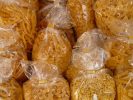Packaging of Processed Foods Agricultural Science Primary 6 Second Term Lesson Notes Week 2
Packaging of Processed Foods
Agricultural Science Primary 6 Second Term Lesson Notes (Week 2)
Topic: Packaging of Processed Foods
Lesson Details
Subject: Agricultural Science
Class: Primary 6
Term: Second Term
Week: 2
Age: 10–12 years
Topic: Packaging of Processed Foods
Sub-topic: Methods, Importance, and Applications of Packaging
Duration: 40 minutes
Behavioral Objectives
By the end of the lesson, pupils should be able to:
- Identify examples of packaged foods.
- Explain the reasons for packaging processed foods.
- Suggest creative ways to package produce harvested from the school farm.
Keywords
- Packaging: Covering or enclosing processed foods to protect and preserve them.
- Processed Foods: Foods that have been prepared and preserved for future use.
- Preservation: Preventing food from spoiling.
- Materials: Substances used for packaging.
Set Induction
The teacher begins the lesson by showing pupils packaged food items such as sachet water, bread in nylon, canned drinks, and bottled honey. The teacher then asks the pupils:
- “Why do you think these foods are packaged this way?”
- “What do you think will happen if these foods are not packaged?”
This creates curiosity and engages the pupils’ interest in the topic.
Entry Behavior
Pupils should already have basic knowledge of farm produce and the importance of preservation from the previous term.
Learning Resources and Materials
- Samples of packaged foods (e.g., sachet water, bread, canned foods).
- Flashcards with pictures of packaging materials.
- Markers and charts for illustrations.


Building Background/Connection to Prior Knowledge
In the last term, pupils learned about preserving farm produce to prevent spoilage. This lesson builds on that knowledge by introducing packaging as a method to keep processed foods safe and attractive for consumption.
Embedded Core Skills
- Communication: Discussing ideas during class activities.
- Critical Thinking: Analyzing why packaging is important.
- Creativity: Designing packaging for school farm produce.
Reference Books
- Lagos State Scheme of Work for Primary 6
- Agricultural Science for Primary Schools
Instructional Materials
- Packaged food items (e.g., sachet water, canned milk).
- Sample packaging materials (e.g., nylon, cartons).
- Charts illustrating different packaging methods.
Packaging of Processed Foods
Definition and Explanation of Packaging
- Packaging: Packaging is the process of covering or enclosing food items to protect and preserve them.
- Processed Foods: These are foods that have been treated or prepared to last longer, such as canned fish, bottled honey, and sachet water.
Reasons for Packaging Processed Foods
- To protect food from dirt, germs, and pests.
- To preserve food and extend its shelf life.
- To make food attractive to buyers.
- To make transportation easier and safer.
- To provide information about the food, like the expiry date and ingredients.
Examples of Packaged Foods
- Sachet water
- Canned tomatoes
- Bottled groundnut oil
- Bread in nylon
- Packaged cereal
Creative Ways to Package School Farm Produce
- Using baskets for fresh vegetables.
- Wrapping cassava or yam in sacks.
- Bottling honey or palm oil.
- Using transparent nylon for grains like rice and beans.
- Carton boxes for eggs.
Evaluation Packaging of Processed Foods
Fill-in-the-Blank Questions with Multiple-Choice Options
- ______ is the process of covering food to protect it.
(a) Washing (b) Packaging (c) Frying (d) Smoking
Answer: b - Packaged food is protected from ______.
(a) light (b) dirt (c) water (d) cooking
Answer: b - Packaged bread is usually enclosed in ______.
(a) nylon (b) glass (c) paper (d) wood
Answer: a - One reason for packaging food is to make it ______.
(a) smell (b) expensive (c) attractive (d) heavy
Answer: c - Packaged milk is an example of ______ food.
(a) raw (b) processed (c) fresh (d) spoiled
Answer: b
Class Activity Discussion
Packaging of Processed Foods
- What is packaging?
Packaging is covering food to keep it safe. - Why is packaging important?
It prevents dirt and extends the food’s shelf life. - What are examples of packaged foods?
Sachet water, canned tomatoes, and bottled honey. - What happens if food is not packaged?
It can spoil or be eaten by pests. - What materials are used for packaging?
Nylon, glass, sacks, and cartons. - Why are expiry dates written on packages?
To show when the food is no longer safe to eat.
Presentation Steps
- Revision of Previous Topic: The teacher briefly revisits “Preservation of Farm Produce” by asking pupils about the methods of preservation.
- Introduction of New Topic: The teacher displays packaged food items and introduces “Packaging of Processed Foods.”
- Pupils’ Contributions: Pupils share their ideas on why foods are packaged. The teacher guides the discussion and corrects any misconceptions.
Teacher’s and Learners’ Activities
Teacher’s Activities
- Explains the meaning of packaging.
- Demonstrates packaging using sample materials.
- Guides pupils during class activities.
Learners’ Activities
- Answer questions on packaging.
- Observe and discuss packaged food items.
- Suggest ways to package farm produce.
Assessment Questions (Short Answer)
- What is the meaning of packaging?
- Name two examples of packaged foods.
- Why do we package processed foods?
- List two materials used for packaging.
- Mention one way to package school farm produce.
Conclusion
The teacher reviews the lesson by asking pupils to list packaged foods and the reasons for packaging. Feedback is provided by correcting pupils’ answers and praising their contributions.
Careers in foods and nutrition




